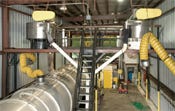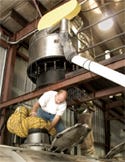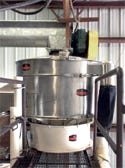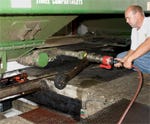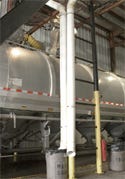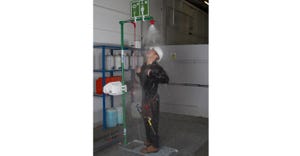Screening Lumps and Foreign Particles from Sugar
February 1, 2008
|
The facility’s Vibroscreen screeners separate sugar lumps (right) from grains. |
The New York, Susquehanna, and Western Railway (NYSW) transports a variety of commodities to its bulk transfer facilities located in the heart of the metropolitan New York market and in upstate New York. One of these NYSW units is Susquehanna Bulk Systems, a food-grade bulk-transfer facility in Sparta, NJ. SBS Sparta specializes in transferring dry-bulk granular sugars from covered hopper railcars into bulk trailers that carry the materials to their final destinations. In the last five years, SBS Sparta has transferred more than 430 million lb of sugar, according to Craig Hemsworth, office manager at the facility.
|
Two 60-in.-diam Kason Vibroscreen screeners are used to load trucks with sugar at the |
Inside a 5000-sq-ft building that holds two railcars, sugar is transferred using one or both of two parallel auger systems. To start the transfer process, a bootjack is elevated until it comes in contact with the bottom of the railcar to be unloaded. Then sugar drops through the sealed opening in the bottom of the railcar and into an under-track auger, which moves the material into a vertical auger. This auger moves the sugar up into an overhead horizontal auger above the truck into which the material will be loaded.
|
Each of the high-capacity discharge Vibroscreen units can screen up to 72,000 lb/hr, allowing trucks to be rapidly loaded with sugar. |
|
Overhead horizontal augers move sugar into the two Vibroscreen screeners in the facility. |
One step remains before the sugar can be fed into the truck. “Sugar tends to lump up, so our customers require the sugar to be sifted to screen out the lumps,” Hemsworth explains.
To remove lumps from granular sugar, the overhead auger feeds the material into a 60-in.-diam, three mesh Vibroscreen circular vibratory screener from Kason Corp., Millburn, NJ. An unbalanced-weight gyratory motor mounted directly beneath the screening chamber produces both vertical and horizontal vibration of the device’s spring-mounted screening deck. The vertical vibration causes sugar particles to pass through apertures in the screen at high rates, while the horizontal vibration moves sugar lumps across the screen in controlled pathways until they exit through a spout at the periphery of the screen and drop into a tailings bin to be discarded.
Besides removing lumps, the process screens foreign objects mixed in with the sugar. “If there’s a rock or other debris in the sugar, the screener will remove it,” Hemsworth says.
|
At the SBS Sparta facility, sugar is transferred from railcars to bulk trailers that carry the materials to their final destinations. |
|
SBS Sparta receives dry-bulk granular sugars in |
After exiting the screener, sugar passes through a rare earth magnet, which removes any metal filings that might be in the material. The screener and magnet are critical control points in SBS’s HACCP program. These points must be identified and maintained as required by the American Institute of Bakers.
The truck rests on a scale under the screener, which sits on two steel beams about 15 ft above the floor of the enclosed loading bay. On-size material ejected through the screener’s bottom discharge port passes through the magnet below the port and drops into the truck. Oversized material exiting the screener’s upper discharge port passes through a 4-in.-diam chute and drops into a tailings bin.
The SBS Sparta facility was designed to accommodate two parallel systems for moving sugar, allowing simultaneous loading of two trucks and continued operation if one system goes down, according to John Fenton, vice president of marketing and sales for NYSW.
In the facility’s early years, however, only one of the systems was functional. To make the second system operational, the new owners of the company installed a second 60-in.-diam Vibroscreen screener with a three-mesh screen. Like the first screener, the second was purchased through Cino Equipment, a Kason representative in Berkeley Heights, NJ. “Since our first Kason sifter was problem-free, we purchased another,” Hemsworth says.
Subsequently, one customer requested finer screening, so the company replaced one of the three-mesh screens with a six-mesh screen. This system discharges into trucks parked on a 240,000-lb scale in the loading bay.
|
Oversized material falls through a 4-in.-diam chute and drops into a tailings bin. |
Hemsworth says the facility typically screens about 250,000 lb of sugar a day, “but we’ve done up to 20 loads a day—almost a million pounds—using both sifters.”
Each of the high-capacity Vibroscreen units can screen up to 72,000 lb/hr. The rate at which material passes through the screeners depends in part on the last time they were cleaned. In conformance with GMP requirements, SBS cleans the screeners with steam and hot water either once a week or after a load. Personnel inspect the screeners after every loading operation to see if immediate cleaning is required. All material contact surfaces are made of Type 304 stainless steel.
Other than cleaning, the screeners require no regular maintenance. As for repairs, Hemsworth says they have been limited to single instances of replacing the springs and redoing the motor windings on the older of the two units. “After 15 years, I guess you have to expect something to eventually wear out,” he says.
For more information, contact Kason Corp. at 973-467-8140 or [email protected], or visit www.kason.com.
You May Also Like

